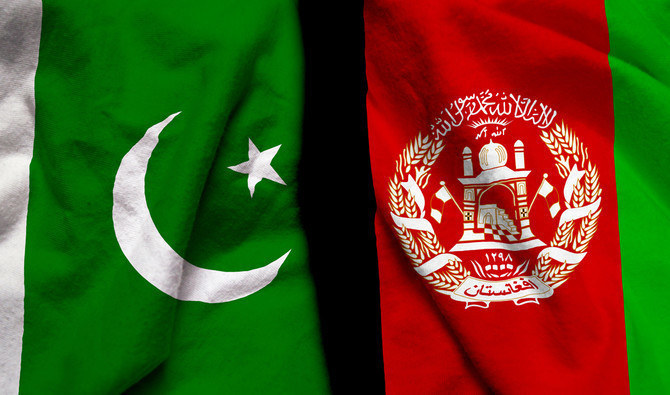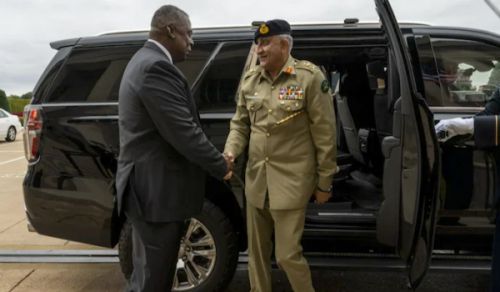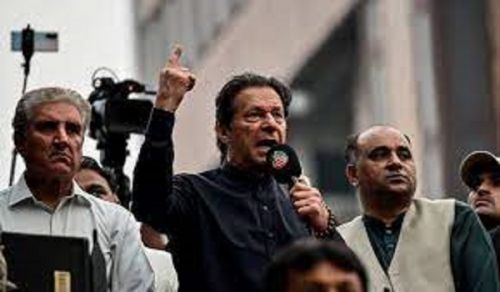Hizb ut-Tahrir Wilayah Pakistan issues policy paper on Inflation

Hizb ut-Tahrir Wilayah Pakistan issues policy paper on Inflation
Only the Khilafah will eliminate the menace of ever rising inflation
Like other currencies, the Dollar, the Pound and the Franc, originally, the Rupee was backed by real tangible wealth in the form of a precious metal. In the case of the Dollar, it was gold, in the case of the Rupee it was silver. This system stabilized the value of the monetary unit both internally within the country and externally in international trade. The evidence for this was that the standard prices of gold in 1910 were almost the same level they were in 1890. Today, there is sufficient gold and silver in the world to support the actual economy, transactions such as buying and selling food, clothing, shelter, luxuries, manufacturing machinery and technology and so on. However, due to capitalist practices, the demand for the creation of money outstripped the supply of gold and silver. The states abandoned the precious metal standard, so that currency became backed only by the authority over the state, allowing more and more notes to be printed, without being backed fully by gold and silver, so the money became worth less, if not almost worthless. Despite the false reassuring claims of the government to the contrary, the Rupee is collapsing constantly, which is leading to huge increases in prices. Yet, the government continues to print more and more money unheeding of the dire consequences, busily digging a grave for the lifeblood of the economy, its currency.
Capitalism mandates interest rate manipulations to control the economy. The privately-owned banks use depositors’ money and deposit it with Pakistan’s state bank in special accounts to earn higher rates of interest. As the State Bank does not have surplus money to pay back the interest to the private banks, it “creates money” by printing more, in order to pay interest to the depositing banks.
The capitalist balance of trade policy through devaluation of the Rupee also leads to inflation. Being a net importer country with a weak manufacturing base, Pakistan’s capitalist government oversees the devaluation of the Rupee, in accordance to IMF orders. This was claimed to be primarily done to address Pakistan’s balance of trade. However, by devaluing the Rupee, the Pakistani government increased the costs of manufacturing inputs, which caused havoc in the agricultural, textile and other sectors that were already reeling from the policy of high interest rates. Hence, the high cost of borrowing, together with the increase in manufacturing costs, rendered many industries and companies unable to compete internationally.
Islam has mandated that the currency of the state is backed by precious metal wealth, ending the root cause of inflation. RasulAllah صلى الله عليه و سلم commanded the Muslims to mint Gold Dinars, weighing 4.25g, and Silver Dirhams, weighing 2.975g, as the currency of the state. This is why the Khilafah enjoyed stable prices for over a thousand years. Return to the gold and silver standard for Muslims is eminently practical. The lands of the Muslims in which the Khilafah state is likely to arise contains a lot of gold and silver resources, such as the Sandaik and Reko Diq fields in Pakistan.
The up coming Khilafah will Strengthen and stabilize the currency by backing it with real wealth, gold and silver, to end the generalized inflation, which has crippled households, industry and agriculture, once and for all.
Note: To see complete policy and its relevant articles of the constitution for the Khilafah state please go to this web link:
Policy regarding crippling rises in prices
Media office of Hizb ut Tahrir in Pakistan
بسم الله الرحمن الرحيم
پیر 30 ربیع الاول، 1434ھ 02/11/2013 نمبر:PN13017
حزب التحریر ولایہ پاکستان نے مہنگائی (افراط زر) کے حوالے سے پالیسی جاری کر دی
صرف خلافت ہی مسلسل بڑھتی مہنگائی کے عذاب کا خاتمہ کرے گی
دوسری کرنسیوں کی طرح، جیسے ڈالر، پائونڈ اور فرانک، روپیہ کی بنیاد بھی اصل دولت یعنی قیمتی دھات پر ہوتی تھی۔ ڈالر کی بنیاد سونے پر جبکہ روپے کی بنیاد چاندی پر ہوتی تھی۔ اس نظام نے کرنسی کی قدر و قیمت کو اندرون ملک اور بیرون ملک بین الاقوامی تجارت میں استحکام فراہم کر رکھا تھا۔ اس کا ثبوت یہ ہے کہ سونے کی جو قیمت 1890ء میں تھی وہی قیمت کم و بیش 1910ء میں بھی تھی۔ آج دنیا میں اس قدر سونا اور چاندی موجود ہے جو دنیا کی اصل معیشت یعنی کاروباری معاملات جیسے خوراک، کپڑے، رہائش، اشیائے ٔ تعیش، صنعتی مشینری، ٹیکنالوجی اور دیگر اشیأ کی خرید و فروخت کے لیے درکار ہے۔ لیکن سرمایہ دارانہ نظام نے کرنسی کی پیداوار کی طلب میں اس قدر اضافہ کر دیا جس کو سونے اور چاندی کے ذخائر پورا نہیں کر سکتے تھے۔ ریاستوں نے قیمتی دھات کے پیمانے کو چھوڑ دیا لہٰذا کرنسی نوٹ کی بنیاد قیمتی دھات سے ہٹ کر جاری کرنے والی ریاست کی طاقت ہو گئی جس کے نتیجے میں ریاستوں کے پاس زیادہ سے زیادہ کرنسی نوٹ چھاپنے کا اختیار آگیااس لیے کرنسی کی قدر و قیمت کا مکمل خاتمہ تو نہیں ہوتا لیکن اس میں مسلسل کمی ہوتی رہتی ہے۔ حکمرانوں کے دعوں کے برعکس روپیہ کسی بھی وقت ردی کے کاغذ میں تبدیل ہو سکتا ہے جس کے نتیجے میں قیمتوں میں انتہائی زبردست اضافہ ہو جائے گا۔ لیکن اس کے باوجود حکومت مسلسل نوٹ چھاپ رہی ہے جس کے بہت ہی خطرناک نتائج نکل سکتے ہیں اور یوں حکومت کرنسی کی قبر کھود رہی ہے جو معیشت کے لیے خون کی حیثیت رکھتی ہے۔
سرمایہ دارانہ نظام شرح سود کے تعین کی اجازت دیتا ہے۔ نجی بینک ذیادہ شرح سود حاصل کرنے کی خاطر اپنے کھاتیداروں کی رقم کو سٹیٹ بینک کے مخصوص اکاؤنٹ میں جمع کراتے ہیں۔ چونکہ سٹیٹ بینک کے پاس نجی بینکوں کو اس سود کی ادائیگی کے لیے زائد رقم موجود نہیں ہوتی تو وہ مزید نوٹ چھاپتا ہے تا کہ سود کی رقم ادا کر سکے۔ اسی طرح سرمایہ دارانہ نظام میں برآمدات اور درآمدات میں توازن پیدا کرنے کے لیے روپے کی قدر کم کی جاتی ہے جس کے نتیجے میں افراط زر پیدا ہوتا ہے۔ چونکہ ہمارا صنعتی شعبہ کمزور ہے اور ہماری درآمدات، برآمدات کے مقابلے میں ہمیشہ زائد ہوتی ہیں۔ لہذا پاکستان کی سرمایہ دارانہ حکومت آئی۔ایم۔ایف (I.M.F) کے حکم پر روپے کی قدر کو کم کر دیتی ہے۔ روپے کی قدر میں کمی کرنے کا مقصد پاکستان کے تجارتی توازن کو بہتر کرنا بتایا جاتا ہے۔ لیکن روپے کی قدر میں کمی کی وجہ سے پاکستان کی حکومت پیداواری لاگت میں اضافہ کر دیتی ہے جس کے نتیجے میں زراعت، ٹیکسٹائل اور معیشت کے دوسرے شعبوں میں ایک افراتفری مچ جاتی ہے کیونکہ وہ پہلے ہی بلند شرح سود کی وجہ سے مشکلات کا شکار ہوتے ہیں۔ لہذا مہنگے قرضے اور پیداواری لاگت میں اضافہ بہت سی کمپنیوں اور صنعتوں کو اس قابل ہی نہیں چھوڑتا کہ وہ بین الاقوامی مارکیٹ میں مقابلہ کرسکیں۔
اسلام نے یہ لازمی قرار دیا ہے کہ ریاست کی کرنسی کی بنیاد قیمتی دھات کی دولت کو ہونا چاہیے جس کے نتیجے میں افراط زر کی جڑ ہی کٹ جاتی ہے۔ رسول اللہ ﷺ نے مسلمانوں کو حکم دیا کہ وہ سونے کے دینار، جن کا وزن 4.25 گرام اور چاندی کے درہم، جن کا وزن 2.975 گرام ہو، ریاست کی کرنسی کے طور پر استعمال کریں۔ اس وجہ سے ہزار سال تک ریاست خلافت میں قیمتوں کو استحکام حاصل رہا۔ مسلمانوں کے لیے سونے اور چاندی کے پیمانے کی جانب دوبارہ لوٹنا عملی طور پر ممکن ہے۔ جن مسلم علاقوں میں خلافت کے دوبارہ قیام کے امکانات ہیں وہ سونے اور چاندی کے وسائل سے بھر پور ہیں جیسے پاکستان میں سینڈک اور ریکوڈیک کے میدان۔
آنے والی ریاست خلافت حقیقی دولت کے ذریعے یعنی سونے اور چاندی کے ذریعے کرنسی کو مستحکم اور طاقتور کرے گی تا کہ عمومی افراط زر کا ہمیشہ کے لیے خاتمہ ہو جس نے گھروں، صنعتوں اور زراعت کو مفلوج کر دیا ہے۔
نوٹ :اس پالیسی دستاویز اور اس سے متعلقہ ریاست خلافت کی آئینی دفعات کو دیکھنے کے لیے اس ویب سائٹ لنک کو دیکھیں۔ کمر توڑ مہنگائی کے خاتمے کی پالیسی
میڈیا آفس حزب التحریر ولایہ پاکستان





